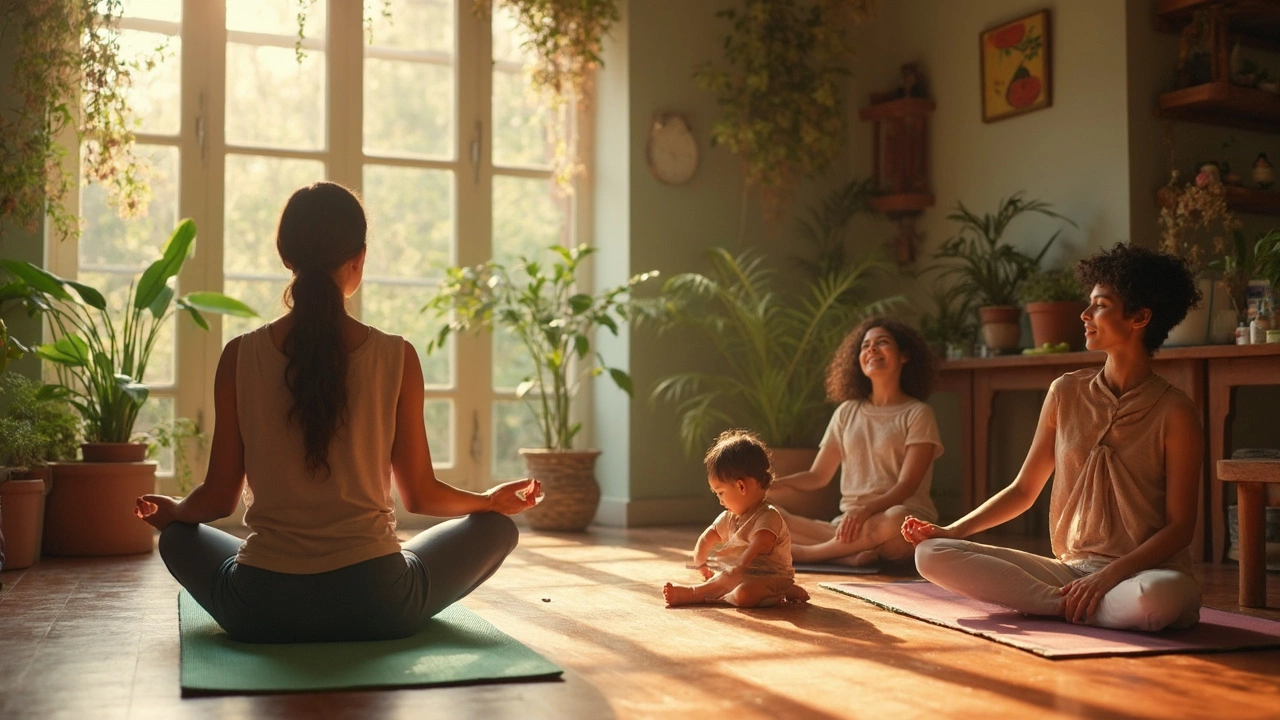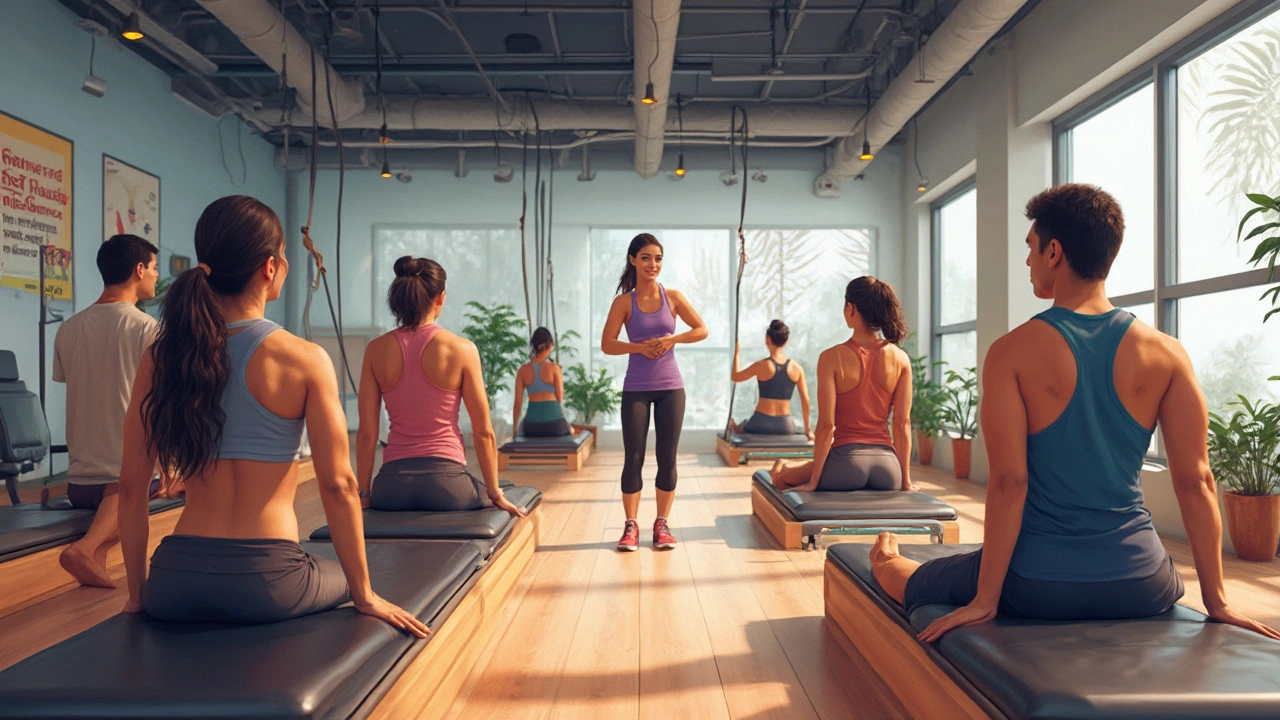Pilates or Yoga: Which One Fits You Best?
 May, 17 2025
May, 17 2025
If you’ve ever scrolled through fitness videos trying to decide between Pilates and yoga, you’re not alone. The choice isn’t just about stretchy pants and calming playlists—these two routines feel totally different in your body, even when the moves look similar on Instagram.
Right off the bat, Pilates tends to focus on core strength, posture, and small, controlled movements. Think planks, bridges, and exercises that wake up muscles you didn’t know you had. In contrast, yoga usually mixes stretching, breathing, and moments of pure stillness. Some flows get your heart going, while others invite you to melt into the mat.
Don’t worry if you’re not super bendy or haven’t touched your toes since elementary school. You can start either one with zero flexibility or experience. The secret is picking what lights you up—you’re way more likely to stick with an exercise routine when it feels good and fits your day. If your goal is to tone up fast or protect your back (parenting, right?), you may lean toward Pilates. Need some calm or a mental reset? Yoga’s got your back—literally and figuratively.
- Pilates vs. Yoga: What's the Real Difference?
- How They Tweak Your Body and Mind
- Choosing Based on Your Goals
- Tips for Getting Started (No Pressure)
Pilates vs. Yoga: What's the Real Difference?
Let’s clear up the confusion. Yoga has been around for thousands of years; it started in India with roots in philosophy and meditation. You’ll see people holding poses, breathing deeply, or just lying still for minutes at a time. Yoga classes often focus on stretching, balance, and calming your mind more than anything else.
Pilates came way later—about a hundred years ago—created by Joseph Pilates in Germany. It was built for muscle rehab and helping people get strong after injuries. Pilates is all about controlled moves, a strong core, and precision. You’ll do plenty of tiny, targeted exercises, sometimes with gear like bands or a reformer bed.
Here’s what really separates the two:
- Pilates is laser-focused on core muscles, alignment, and stability. It’s about building strength from the inside out—especially your abs, back, and hips. Classes usually have a set order, and every move is about control.
- Yoga blends stretching and strength but puts a big spotlight on breath and mindfulness. The pace can swing from slow and gentle to fast and sweaty. There’s often a spiritual side—it’s not just about your muscles.
- Pilates instructors talk a lot about ‘neutral spine’ and keeping your joints safe. Yoga teachers are usually big on breathing and letting go of stress.
Still, there’s plenty of overlap. Both can improve flexibility and posture, and both can leave your muscles shaking after a good class!
“The main difference between Pilates and yoga is that Pilates exercises are more focused on strengthening the core, while yoga incorporates more flexibility and balance work,” says Alyssa Ages, certified fitness instructor, in a 2024 interview with Healthline.
In short, if you’re hunting for pure core power, Pilates is for you. If you want to stretch, relax, and connect with your breath, give yoga a go. Either way, you’re doing your body a favor.
How They Tweak Your Body and Mind
Both Pilates and yoga deliver much more than a workout. The big difference is how they hit your muscles and brain. Let’s break it down so you really get what you’re signing up for.
Pilates loves your core. Seriously, every session is about building up strength from your center, which includes abs, lower back, hips, and butt. The moves are all about control and small muscle engagement. This can mean fewer injuries if you’re lifting kids or sitting at a desk all day. Plus, there’s science backing this up: the American Council on Exercise found that Pilates can boost core endurance by up to 21% in less than two months for beginners.
Yoga’s secret weapon is its breathwork. You flow from pose to pose, stretching muscles and getting that deep release, but you’re also calming your mind. This isn’t just good vibes—Harvard Health points out, “Regular yoga practice has a proven positive effect on depression, stress, and anxiety.”
“The mental benefits of yoga are as powerful as its physical ones, cutting stress levels and strengthening emotional control,” says Dr. Sat Bir Khalsa, assistant professor of medicine at Harvard Medical School.
If you like numbers, check out this quick side-by-side:
| Pilates | Yoga | |
|---|---|---|
| Main Focus | Core strength, stability, posture | Flexibility, balance, relaxation |
| Impact on Mood | Boosts energy, improves body awareness | Reduces stress and anxiety |
| Typical Session | Reps of controlled, precise moves (with or without gear) | Poses and flows synced with breath |
| Calories Burned (per hour) | 180–250 (beginner) | 175–300 (depending on style) |
One thing to remember: both routines work your whole body, but in different ways. Pilates feels a bit like intense balance work, sneaking up on muscles you didn’t know were slacking. Yoga feels like a stretch for body and mind, with the bonus of a mental timeout.

Choosing Based on Your Goals
Most people don't wake up wondering if they want to work their core or meditate—they just want to feel better, move easier, or handle stress. Your goal shapes whether Pilates or yoga fits your life better. Here’s how to break it down:
- Want a stronger, more stable core? Clinical research by Mary Ellen Snodgrass ("The Encyclopedia of Exercise, Sport and Health") shows that Pilates can boost abdominal muscle endurance up to 21% in just 8 weeks. If low back pain is nagging you, those core stabilizers get the job done.
- Looking for whole-body flexibility? Traditional yoga routines, especially hatha or yin yoga, are famous for improving flexibility and joint movement. A study from the International Journal of Yoga found that practicing yoga twice a week for 10 weeks improved hamstring flexibility by 30% for beginners.
- Need stress relief or better sleep? Yoga is legendary for helping calm the jitters. Slow flow, restorative, or even bedtime yoga can lower cortisol (the stress hormone) and help you sleep deeper. Pilates helps too, just not as much on the mental side.
- Want faster toning or rehab? Pilates zeroes in on muscle strengthening and posture fix-ups, which makes it super popular for physical therapy. According to the American Council on Exercise, Pilates is often used by athletes to recover from injuries and build balance.
“Pilates develops the body uniformly, corrects wrong postures, restores physical vitality, invigorates the mind, and elevates the spirit.” —Joseph Pilates (creator of Pilates)
Need to see the differences laid out? Here’s a quick cheat sheet:
| Goal | Best for Yoga | Best for Pilates |
|---|---|---|
| Flexibility | ✔️ | ➖ |
| Core Strength | ➖ | ✔️ |
| Stress Relief | ✔️ | ➖ |
| Posture/Back Pain | ➖ | ✔️ |
| Spiritual/Mental Benefits | ✔️ | ➖ |
Still can’t pick? Some people do both! If you try a class and it feels dodgy or boring, know there are so many different styles out there—just like you wouldn’t judge all pizza by one slice. Try a few, ask real people what they love, and listen to your body. It’s about what works for you, not what’s trending.
Tips for Getting Started (No Pressure)
Starting with Pilates or yoga doesn’t have to be a big deal—no need for fancy gear or perfect technique. Loads of people get into it with just a mat from a discount store and videos on YouTube. You don’t have to be flexible or super strong; beginners are what classes are made for.
The key is to keep things simple and realistic. Here’s what makes a difference when you start:
- Pick one: Try a short beginner video (under 20 minutes) and see if you enjoy Pilates’ core work or yoga’s calm vibe more. Search for “beginner pilates” or “gentle yoga” to avoid the advanced stuff that can scare newbies away.
- Set a schedule you’ll actually do. Even two sessions a week is more than enough to notice changes. If you’re a parent, fit it in while your kid watches a show—no shame.
- Clear some floor space. You don’t need a studio. A quiet corner where you can move around without bumping into toys or coffee tables works fine.
- Focus on form, not speed. Pilates especially is all about small, controlled moves, so don’t rush it. Yoga gives you permission to rest any time in child’s pose.
- Listen to your body. A little muscle burn or stretch is normal, but sharp pain is a no-go. Modify moves as you need and skip anything that doesn’t feel right.
- If money’s tight, skip the memberships at first. There are thousands of free classes online from legit instructors. Later, you might want in-person classes for the social side or more coaching.
Check out some quick facts. A 2023 survey by Mindbody found that 42% of people tried both yoga and Pilates before settling into one—so sampling both is totally common.
| What You Need | Pilates | Yoga |
|---|---|---|
| Mat | Yes, non-slip if possible | Yes, note if it's cushy |
| Other gear | Optional: mini ball, resistance bands | Optional: blocks, strap |
| Space needed | About 6x3 feet | About 6x3 feet |
| Typical class time | 20–60 minutes | 15–75 minutes |
Final tip: Don’t worry about looking silly. Everyone feels awkward their first week. With a little practice, things get less weird and a lot more comfortable.
